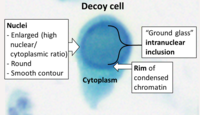| BK virus | |
|---|---|
 | |
| Cytology of a polyomavirus infected cell, using Papanicolaou stain. The high nuclear to cytoplasmic ratio makes it resemble cancer (thus the name "decoy cell") but the inclusion body reveals its viral pathophysiology. | |
| Specialty | Infectious disease |
The BK virus, also known as Human polyomavirus 1, is a member of the polyomavirus family. Past infection with the BK virus is widespread,[1] but significant consequences of infection are uncommon, with the exception of the immunocompromised and the immunosuppressed. BK virus is an abbreviation of the name of the first patient, from whom the virus was isolated in 1971. This patient - a male - was then 39 years old, who had developed constriction of the ureter after a renal transplant.[2]
- ^ Tagliapietra A, Rotondo JC, Bononi I, Mazzoni E, Magagnoli F, Maritati M, Contini C, Vesce F, Tognon M, Martini F (2019). "Footprints of BK and JC polyomaviruses in specimens from females affected by spontaneous abortion". Hum Reprod. 34 (3): 433–440. doi:10.1093/humrep/dey375. hdl:11392/2397214. PMID 30590693. S2CID 58621197.
- ^ Pahari A, Rees L (August 2003). "BK virus-associated renal problems-clinical implications". Pediatr Nephrol. 18 (8): 743–748. doi:10.1007/s00467-003-1184-3. PMID 12802640.